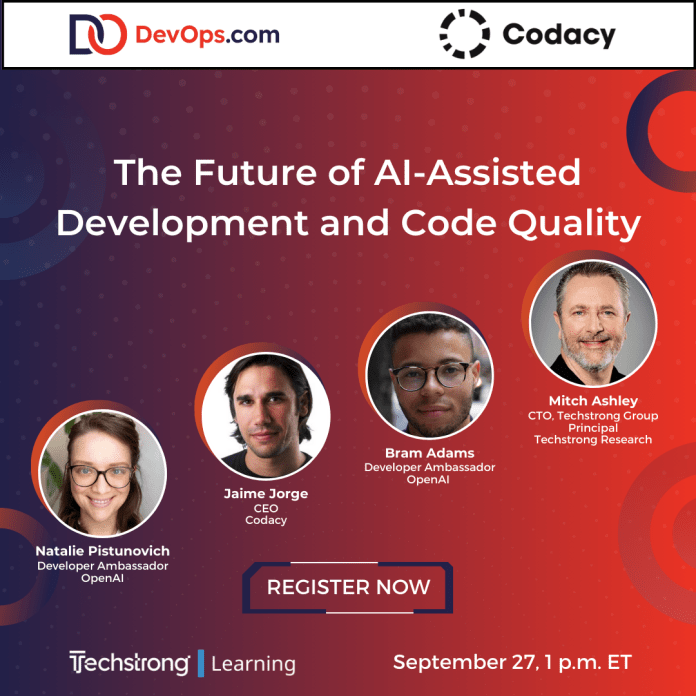Webinar Recap: The Future of AI-Assisted Development and Code Quality

We hosted a webinar on September 27 in collaboration with Techstrong Learning, which focused on how artificial intelligence (AI) is powering great change in the software development industry.
Joining Codacy CEO Jaime Jorge in the roundtable discussion were two developer ambassadors from the biggest company in AI today, Open AI, Natalie Pistunovich and Bram Adams. The discussion was moderated by Techstrong Research CTO Mitch Ashley.
Let’s take a look at some of the key insights and takeaways from the talk:
AI Adoption: Who’s Using These Tools and How?
We already know that developers are using AI-assisted coding tools. A recent GitHub survey found that 92% of developers polled actively use these tools.
We know developers are on board, but what about the companies they work for? According to Jorge, many Codacy customers he has talked to are on the fence and still weighing the pros and cons of AI-assisted coding.
“Most customers that we’re talking to are still deciding—still defining their policies and looking to make decisions on their official stance on AI tooling,” he said.
“We see two groups: people who are starting to use it occasionally and in a more frequent manner over time, and then we have people who sometimes will oppose or just not adopt them,” Jorge added.
When asked about how popular AI tools like OpenAI’s ChatGPT and GitHub’s Copilot are being used most commonly, Adams said that AI-coding tools are helping developers get started on their code more easily.
“Specifically, where I’ve seen the most lift for people in getting from zero to one in terms of trying things out with their code,” Adams said.
“So it’s not necessarily about the already written code you’re trying to put to production from development. It’s more about ‘How can I even get started writing this?’ And ChatGPT and Copilot are tools that are really good at allowing you to say just kind of, ‘What would this even look like in code? Give me a wide overview of what I’m looking to do here,’” he said.
Taking Responsibility: What New Roles Will Developers Play?
If the AI tool is generating your code, what role does the developer play if they aren’t manually writing code any longer? Humans are still writing code, but Jorge believes that the responsibility for maintaining code quality and security is where the focus will shift as the AI tools become better at coding.
“The magic (of AI) leads you to think that you can fully outsource the intelligence, but you can’t. You have a lot of responsibility in making sure that you review the code and that you put a lot of design and time into giving it a good prompt as well,” Jorge said.
“So, if you don’t put intention and thought into how you use AI, I think implicit design decisions will be made for you, and that’s not good,” he added.
Pistunovich believes that AI coding is going to make companies think long and hard about the languages and technologies they are working with, claiming that some languages simply work better with AI than others.
“Python has been around long enough to have all sorts of code base lying around the internet that has, at best, just bad practices but also straight-ahead malicious code or just libraries that are bad. And some newer languages just have less of that,” she said.
Predictions: What’s Next for AI-Assisted Development?
Adams believes that AI coding tools are going to enable non-technical people to be more involved in software creation.
“We’re going to get a lot more people who aren’t necessarily traditional developers being able to map out their particular problem,” he said.
A recent Stack Overflow survey showed that 33% of developers see improved productivity as the most valuable benefit of AI coding tools. Jorge agrees.
“I think we’re going to see tons of efficiency and speed. There’s an expectation that dev cycles will be faster, with increased speed of development and improved tooling,” he said, adding that he also expects AI to become more embedded in the integrated development environment (IDE).
Want to watch the entire webinar? Click on the image below to access it.
.svg)



